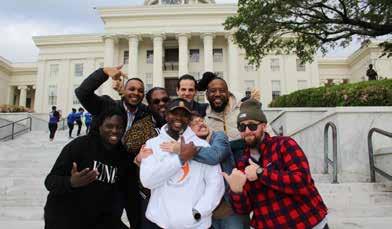
5 minute read
Deep South Pilgrimage Inspirational for Charlotte Black/Jewish Alliance
The Charlotte Jewish News, June/July 2023
By Mary Eshet
In April, vandalism at Davidson College involved a blackboard with slurs, swastikas, a drawing of Hitler in chalk and a handwritten message about killing “Jews and n******.” This offensive graffiti illustrates the legacy of hate and oppression Blacks and Jews share. The Charlotte Black/Jewish Alliance, sponsored by the Stan Greenspon Holocaust and Social Justice Education Center at Queens University and Johnson C. Smith University, seeks to unify Blacks and Jews to combat hate and promote social justice.
As a member of the first cohort of the Alliance, Terrell Hamlet’s hope was for more people to get involved. “We want to be the hope and light to any darkness. I never want to see this end,” he said.
Hamlet’s aspirations are coming to life as he co-chairs the second cohort, 14 young leaders from different professions and backgrounds who began the program in December. The group meets monthly for programs, including sessions led by the faculty: Dr. Melvin Herring and Dr. Cindy Kistenberg, from Johnson C. Smith University and Rabbi Judy Schindler, director of the Stan Greenspon Center.
The first and second cohorts use words like “transformational” and “inflection point” to describe the Deep South Pilgrimage that is part of the program.
Aishaah Reed Foster said the trip was phenomenal. “I never wanted to go to Alabama or Mississippi. I felt a lot of trepidation. But it turned out to be amazing. I was astonished about the history we were able to observe – it’s a different feel when you’re in the South, where it happened.”
Aishaah, who is Black, was a public school teacher of history and the Holocaust before she went to law school. Today she is an attorney with Moore and Van Allen in Charlotte.
Rachael Coe, who is Jewish, is also an attorney with Moore and Van Allen. “To be in the places where history happened, you really feel a buzz in the air; it’s like an out-of-body experience,” she said.
Hal Levinson, a partner at Moore and Van Allen, is thrilled Rachael and Aishaah are participating in the Alliance. “We take our commitment to the community very seriously, and encourage lawyers to find ways to get involved that are meaningful for them,” he said. “It’s terrific for them, for the community, and also for our firm, because they bring back things they’ve learned and become better lawyers as they represent clients from different backgrounds.”
The group boarded the bus early Thursday, March 16. Over the next four days they would spend hours reflecting, having honest conversations, laughing, crying, and singing. They heard from the co-chair of the Atlanta Black Jewish Coalition, learned about Jewish engagement in the Civil Rights Movement in Birmingham, toured the Birmingham Civil Rights Institute and the 16th Street Baptist Church, visited the Equal Justice Initiative Legacy Museum in Montgomery, walked across the Edmund Pettus Bridge in Selma (the site of the brutal Bloody Sunday beatings of civil rights marchers in 1965), and shared a Friday night Shabbat experience.
Mohammed Jibriel, a Black Muslim and Queens University graduate working on his PhD in public health at University of North Carolina Greensboro, said the number one lesson he took away from the trip and the shared legacy between Blacks and Jews is that “all forms of bigotry are interconnected – we can’t dismantle one form without addressing the others.”
The educational experiences of the trip were topped only by the opportunity to deepen rela tionships among participants. “I came away with incredible new friends in our community I wouldn’t have otherwise crossed paths with. We had the opportu nity to reflect on our experiences and to be vulnerable. At the same time, we had so much fun,” said Rachel.
Mohammed remembers a highlight of the trip just after they visited the EJI Legacy Museum in Montgomery, which showcases the very difficult history of slavery, lynching and incarceration. “We were speechless and worn out when we left the museum,” he said. As they struggled with their thoughts standing in front of the state capitol, suddenly they were in the midst of the finish line for the Selma to Montgomery race and bike ride. The crowd was festive, laughing and dancing – and the group from Charlotte joined in.
“I felt a moment of guilt,” said Mohammed. “We’d just left the museum of such tragedy, and then we were dancing. But then I saw us – a group of Blacks and Jews dancing there on the same steps where Jefferson Davis was sworn in as President of the Confederacy. The guilt turned to joy and liberation as I understood that WE are the dream Martin
Luther King, Jr. spoke of.”
The last stop was to walk across the Pettus Bridge – and then continue in their efforts to cross more bridges and carry the message of unity to a broader community as they began the journey home.
Cover photo caption: The trip included a visit to Birmingham’s 16th Street Baptist Church where on Sunday, September 15, 1963, at 10:22 a.m., a bomb exploded and killed four young girls attending Sunday School.

The second cohort of the Black/Jewish Alliance bond with hope and joy in front of the Alabama State Capitol in Montgomery










